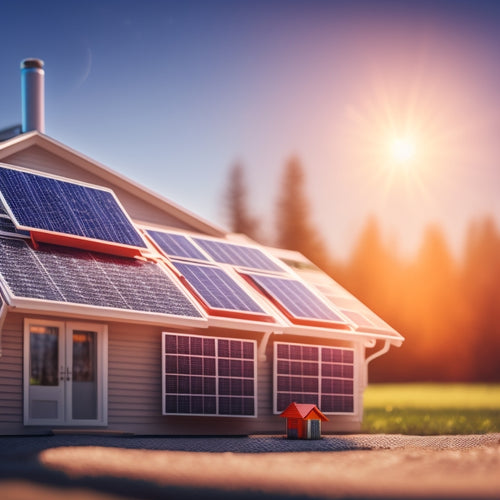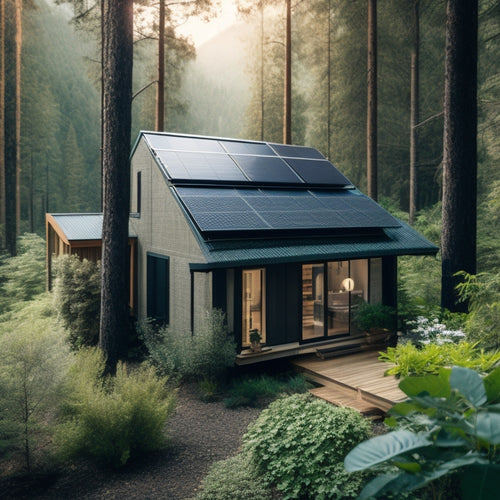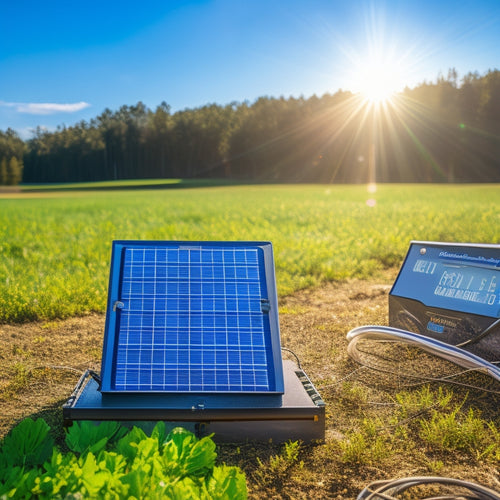
7 Best DIY Energy Savings Strategies
Share
By implementing DIY energy savings strategies, you can greatly reduce your energy bills. Utilizing natural light power through advanced window technologies, insulation, and reflective surfaces can minimize artificial lighting needs. Proper insulation and air sealing prevent heat escape, while DIY solar solutions like solar panels and renewable energy sources provide clean energy. Energy monitoring and management tools, such as smart home automation systems, help identify inefficiencies and optimize energy usage. Additionally, automated energy control and energy-efficient window solutions can further reduce energy consumption. By applying these strategies, you'll be on your way to revealing substantial energy savings and can next investigate advanced techniques to maximize your energy independence.
Overview
- Harnessing natural light through window placement and light enhancement techniques reduces reliance on artificial lighting and energy consumption.
- Comprehensive insulation and air sealing prevent heat escape and energy loss, ensuring optimal energy efficiency in homes.
- DIY solar solutions, such as installing solar panels, provide access to clean energy from sunlight and reduce energy bills.
- Energy monitoring and management tools offer real-time insights into energy consumption, enabling informed decisions to optimize energy usage.
- Automated energy control through smart home systems and programmable devices facilitates scheduling and remote monitoring for maximum efficiency.
Harnessing Natural Light Power
Your windows are a portal to free energy, and utilizing natural light power can greatly reduce your reliance on artificial lighting. By adopting light diffusion techniques, you can maximize the natural light benefits in your home. This involves strategically placing mirrors, prisms, or other reflective surfaces to bounce light deeper into your space.
Additionally, incorporating energy-efficient window technologies, such as energy-gathering window technologies, can change your windows into power-generating devices. As a result, you'll enjoy improved visibility, reduced eye strain, and a significant decrease in your energy consumption.
DIY Solar Panel Installation
Installing solar panels can be an intimidating task, but with the right guidance, you can make use of the power of sunlight and start generating clean energy for your home.
To guarantee a successful installation, consider key considerations for DIY solar systems such as high-efficiency panels, durable mounting systems, and reliable inverters.
You'll need to choose the right solar panel type for your climate and energy needs, such as monocrystalline, polycrystalline, or thin-film.
Next, gather the necessary installation tools, including a drill, wire cutters, and a multimeter. Confirm you have a sturdy roof and a clear path for sunlight.
Follow safety guidelines and local building codes when installing the panels. Connect the panels to an inverter, and then to your electrical panel.
With careful planning and execution, you'll be tapping into free energy from the sun and reducing your reliance on the grid.
Insulating Your Home Properly
You can greatly reduce heat loss and energy consumption by sealing air leaks and adding insulation throughout your home.
Start by identifying gaps and cracks around windows, doors, and electrical outlets, and seal them with caulk or spray foam to prevent warm air from escaping.
Next, inspect your attic, walls, and floors to determine where additional insulation is needed to optimize your home's energy efficiency.
By integrating Deep Cycle batteries into your energy system, you can store excess energy generated from renewable sources, ensuring a reliable power supply during periods of low energy production.
Additionally, consider implementing energy storage solutions to prepare your home for periods of low energy production, maintaining a stable power supply.
Seal Air Leaks
How much energy are you wasting due to air leaks in your home? You'd be surprised at the amount of heat that escapes through tiny gaps and cracks.
To minimize drafts, start by checking vents, doorways, and windows for air leaks. Use drafting weatherstripping to seal gaps under doors, and caulk windows to prevent heat from escaping.
Don't forget to insulate outlets and switches to prevent energy loss. Assess your home's insulation by testing airflow and identifying areas that need improvement.
Add Insulation Everywhere
Sealing air leaks is just the first step in maximizing your home's energy efficiency.
Now, it's time to add insulation everywhere to prevent heat from escaping. Start by checking your attic insulation, which should have a minimum R-value of R-38.
Don't forget about basement insulation, wall insulation, floor insulation, and crawl space insulation - all of which can be upgraded with fiberglass batts or spray foam.
Insulate your garage, too, to keep it warm and reduce energy loss.
Don't overlook door insulation and window insulation, which can be improved with weatherstripping and door sweeps.
Energy Efficient Window Solutions
Three decades of research have consistently shown that windows are a considerable source of heat loss in buildings, accounting for up to 30% of the total energy consumption. You can greatly reduce this energy loss by implementing energy-efficient window solutions.
| Solution | Description |
|---|---|
| Window Films | Apply a thin film to the glass to reduce heat transfer |
| Thermal Curtains | Hang heavy, thick curtains to insulate and block cold air |
| Energy Efficient Shades | Install shades with high R-values to reduce heat loss |
| Window Replacement | Replace old, single-pane windows with energy-efficient, double-pane ones |
| Glazing Options | Apply low-e coatings or use insulated glass units for better insulation |
Consider these solutions to reduce heat loss and energy consumption. You can also investigate storm windows, tinting solutions, and window seals to further improve energy efficiency.
Smart Home Automation Systems
You're likely familiar with the concept of smart home automation systems, but you may not know how to utilize them to maximize your energy savings.
By integrating various systems, such as lighting and HVAC, you can create a seamless and efficient energy management system.
With energy monitoring tools and automated energy control, you'll be able to track and adjust your energy usage in real-time, making it easier to identify areas for improvement.
System Integration Options
Streamline your energy-saving efforts by embracing system integration options, which can seamlessly merge your smart home automation systems with your DIY energy-saving strategies.
You'll need to verify system compatibility, as integration challenges can arise when combining different devices and platforms.
Research the integration capabilities of your smart home devices and energy-saving systems to verify a smooth merge. Look for systems with open APIs, standardized communication protocols, and compatible data formats.
By integrating your systems, you'll be able to automate energy-saving tasks, receive real-time energy usage data, and optimize your energy consumption with ease.
This harmonious blend of technology and sustainability will give you the freedom to take control of your energy usage and make a positive impact on the environment.
Energy Monitoring Tools
Your smart home automation system's energy monitoring tools are the eyes and ears of your energy-saving operation, providing you with real-time data on your energy consumption.
These tools help you identify areas of inefficiency, allowing you to make informed decisions about your energy usage. By analyzing your energy consumption patterns, you can pinpoint devices or appliances that are using excessive energy, and take corrective action.
Energy monitoring tools also provide you with detailed reports on your energy usage, helping you track your progress and make adjustments as needed.
With real-time data at your fingertips, you'll be able to optimize your energy consumption, reduce waste, and save money on your utility bills.
Automated Energy Control
With automated energy control, your smart home automation system takes energy efficiency to the next level by seamlessly integrating with various devices and appliances to optimize energy usage.
You can automate lighting, temperature, and blinds to create a comfortable living space while minimizing energy waste. Smart thermostats and programmable plugs enable you to schedule energy-intensive tasks during off-peak hours, reducing your energy bills.
Remote monitoring allows you to track your energy usage patterns and identify areas for improvement. Through energy audits and demand response, you can optimize your energy management and make data-driven decisions.
Renewable Energy Storage Options
Several renewable energy sources, such as solar panels and wind turbines, have become increasingly popular in recent years.
You're likely considering integrating them into your DIY energy savings strategy. To maximize their potential, you'll need to investigate renewable energy storage options.
Advances in battery technologies have made solar batteries and home batteries more efficient and affordable. Energy storage systems enable you to utilize renewable resources and achieve grid independence.
With energy management systems, you can optimize your energy usage, reducing peak shaving and load shifting. By investing in storage systems, you'll be able to store excess energy generated during the day for use during the night or on cloudy days, giving you greater control over your energy usage and costs.
Optimizing Home Energy Usage
Energy-efficient homes begin with a thorough understanding of your daily energy usage patterns. Conducting an energy audit helps identify areas of inefficiency, allowing you to make targeted behavioral changes.
Replace inefficient appliances with energy-efficient ones to reduce peak demand and lower your utility rates. Consider incorporating thermal mass materials into your home design to regulate interior temperatures and reduce the need for heating and cooling.
Adjust your energy habits according to weather patterns, and establish regular maintenance routines to ascertain your systems are running at peak levels.
Frequently Asked Questions
Can I DIY Energy-Efficient Upgrades if I'm Not Handy?
You don't have to be a skilled handyman to make energy-efficient upgrades; you can still DIY with budget-friendly options like swapping incandescent bulbs for LEDs or adding insulation, which are simple yet effective ways to reduce energy consumption.
How Long Does It Take to See Energy Savings Results?
Like a detective tracking down clues, you'll start uncovering energy savings results in no time. With energy monitoring and simple behavioral changes, you'll see a noticeable drop in your utility bills within 2-3 months, giving you the freedom to enjoy your hard-earned savings.
Are Energy-Efficient Appliances Worth the Extra Cost?
You're assessing the cost of energy-efficient appliances, wondering if they're worth the initial investment. Yes, they are! While they may cost more upfront, you'll reap long-term benefits like reduced energy consumption and lower utility bills, giving you financial freedom and a clearer conscience.
Can Energy-Efficient Upgrades Increase My Home's Value?
Fast-forward to the future, like a time-traveling DeLorean, and imagine selling your pad - you'll be thrilled to know that energy-efficient upgrades can enhance your home's appraisal and resale value, giving you a competitive edge in the market, and the freedom to reap the financial rewards!
Do Energy-Efficient Upgrades Require Frequent Maintenance?
You'll be relieved to know that energy-efficient upgrades typically don't require frequent maintenance, thanks to their designed longevity. Follow simple maintenance tips, like cleaning filters and inspecting seals, to guarantee your eco-friendly investments continue to pay off without hassle.
Ready to Buy
By implementing these 7 DIY energy savings strategies, you'll be saving energy like a pro! You'll be swimming in a sea of savings, with dollars stacking up like mountains. From utilizing natural light power to optimizing home energy usage, these tactics will change your home into an energy-efficient haven. So, get started today and watch your energy bills plummet - it's a bright, sustainable future ahead!
Related Posts
-

A Beginner's Guide to Navigating the Solar Investment Tax Credit
You're eligible to claim a significant Solar Investment Tax Credit (ITC) of 30% of total installation costs, but mane...
-

Off Grid Solar Batteries
As you shift to off-grid living, you'll rely on high-performance solar batteries to store excess energy generated by ...
-

Choosing the Right Solar Power Charge Controller
Choosing the right solar power charge controller is crucial for maximizing energy efficiency and extending battery li...


